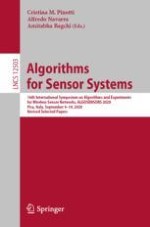2020 | OriginalPaper | Chapter
Live Exploration with Mobile Robots in a Dynamic Ring, Revisited
Authors : Subhrangsu Mandal, Anisur Rahaman Molla, William K. Moses Jr.
Published in: Algorithms for Sensor Systems
Publisher: Springer International Publishing
Activate our intelligent search to find suitable subject content or patents.
Select sections of text to find matching patents with Artificial Intelligence. powered by
Select sections of text to find additional relevant content using AI-assisted search. powered by
